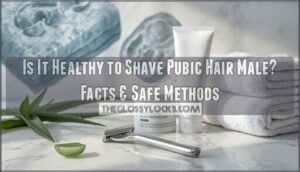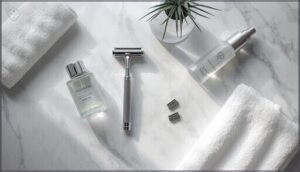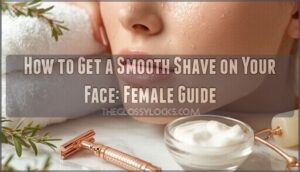This site is supported by our readers. We may earn a commission, at no cost to you, if you purchase through links.
Your grooming routine is more than skin deep—literally. When you pick up a razor to shave your pubic area, you’re making a choice that affects your skin’s natural defenses, its microbiome, and your vulnerability to infections.
The simple act of dragging a blade across sensitive skin creates microscopic openings that can become gateways for bacteria, while removing hair that’s been protecting you from friction and microbial threats since puberty.
Despite what product marketing might suggest, keeping pubic hair doesn’t compromise cleanliness, and removing it doesn’t prevent infections—in fact, clinical evidence points in the opposite direction.
Understanding the real trade-offs between personal preference and biological function helps you make grooming decisions that work for your body, not against it.
Table Of Contents
- Key Takeaways
- Is It Healthy to Shave Male Pubic Hair?
- Benefits and Drawbacks of Shaving
- Health Risks and Common Skin Issues
- Best Practices for Safe Pubic Hair Shaving
- Alternatives to Shaving and Safer Options
- Frequently Asked Questions (FAQs)
- Should you shave male pubic hair?
- Does shaving pubic hair boost confidence in men?
- What happens if you shave pubic hair?
- Should male pubic hair be groomed?
- Why is pubic hair important?
- How do you trim pubic hair for men?
- Can pubic hair removal impact fertility or hormones?
- How does age affect pubic hair grooming decisions?
- Are there specific medical conditions that prohibit shaving?
- Conclusion
Key Takeaways
- Pubic hair serves real protective functions—it reduces friction, supports your skin’s microbiome, and acts as a natural barrier against pathogens, meaning removal increases infection risk rather than improving hygiene.
- Shaving creates microscopic skin openings that raise your vulnerability to bacterial infections and STIs, with studies showing extreme groomers face 4.4 times higher odds of cutaneous sexually transmitted infections.
- If you choose to shave, proper technique matters most—use sharp blades, shave with the grain, wait 24-48 hours between sessions, and consider trimming as a safer alternative that preserves your skin’s natural defenses.
- The hygiene argument for removal doesn’t hold up medically—regular washing with mild soap keeps you just as clean without the injury risks, irritation, and constant maintenance that shaving demands.
Is It Healthy to Shave Male Pubic Hair?
Shaving pubic hair is a personal choice, but it’s worth understanding what the medical community actually says about it.
Pubic hair has real protective functions that go beyond what most people realize.
Let’s clear up some common myths and look at the facts from a health perspective.
Medical Perspective on Shaving
While shaving isn’t medically necessary, clinical guidelines recognize it as a common cosmetic choice. From a health standpoint, you’re introducing measurable risks—barrier disruption, skin infections, and increased infection susceptibility, including sexually transmitted infections.
Research shows that intact pubic hair aids protective functions through microbiome impact and friction reduction. Medical considerations weigh these health risks against personal preference, emphasizing that keeping pubic hair doesn’t compromise cleanliness.
Shaving with a razor can cause microscopic erosions on the skin.
Natural Functions of Pubic Hair
Your pubic hair isn’t just sitting there—it’s working. It reduces friction during movement and sex, protecting delicate skin from microtrauma that pathogens could exploit.
Pubic hair reduces friction during movement and sex, protecting your skin from microtrauma that pathogens could exploit
The hair bolsters your skin microbiome and thermoregulation while trapping sebum with antimicrobial properties. It even plays a role in pheromone signaling and sensory functions, creating natural protection that contributes to overall skin health and body hair hygiene.
Additionally, it acts as a natural barrier against irritation and infection.
Myths Vs. Facts About Pubic Hair Removal
Despite all that protective work, popular beliefs about male pubic hair shaving don’t match reality. Many men cite hygiene as their reason for grooming, yet clinical evidence shows that normal washing keeps you just as clean.
Removing hair doesn’t prevent STIs—in fact, 23.7% of male groomers report injury rates from hair removal, and shaving techniques can create tiny entry points that increase infection risks rather than eliminating them.
Benefits and Drawbacks of Shaving
Shaving your pubic hair comes with a mix of real benefits and some less appealing trade-offs that you should know about before picking up a razor. Some men appreciate the cleaner feel and look, while others find the upkeep and skin reactions aren’t worth the effort.
Let’s break down what actually happens when you shave so you can decide if it’s right for you.
Hygiene and Cleanliness Considerations
You might assume that shaving cleanliness goes hand-in-hand with improved cleanliness, but research tells a different story. Studies show that 61% of men cite hygiene as their motivation for intimate hygiene, yet pubic hairs purpose includes supporting microbial balance and reducing bacterial growth.
Regular hygiene practices—washing with gentle soap—maintain odor control effectively without removal. Hair doesn’t compromise personal hygiene and grooming when you keep it clean.
Aesthetic and Sensory Effects
When you remove hair from the pubic area, you’re making a choice that affects both how you look and what you feel. National surveys show that 60% of men groom for visual appeal, rating themselves more attractive afterward.
Shaving exposes more skin, which can intensify genital sensation during intimate moments—38% notice a difference in tactile experience.
Partner preferences also play a role, with 40% of men reporting grooming requests from partners, linking aesthetic considerations of shaving to body image and sensory comfort.
Impact on Confidence and Intimacy
Confidence often shifts once the razor does its work—you may find yourself feeling more comfortable in intimate situations. A 2023 study shows that 69% of men who groom report higher satisfaction with genital appearance, which directly affects body image and partner attractiveness.
- Sexual activity preparation: 73% groom before sex, linking grooming to intimacy dynamics
- Partner preferences: 40% respond to requests, shaping confidence and self-esteem
- Perceived appeal: Groomers consistently rate themselves as more attractive to partners
Maintenance and Regrowth Issues
Regrowth discomfort begins within days, as stubble emerges and creates itching or irritation. Pubic hair regrows at roughly 1 centimeter monthly, requiring constant maintenance every few weeks to keep a smooth appearance.
Frequent shaving dramatically increases injury risk—men who remove all hair 11 or more times nearly double their odds of cuts, ingrown hairs, and folliculitis compared to those who don’t groom regularly.
Health Risks and Common Skin Issues
Shaving your pubic area comes with certain health risks that are important to understand before you pick up a razor. The sensitive skin in this region is prone to several issues, from minor irritation to more serious complications that can affect your comfort and well-being.
Let’s look at the most common problems you might encounter and what you can do to prevent them.
Skin Irritation and Razor Burn
Razor burn feels like fire on delicate skin, and it’s one of the most common grooming injuries men face. About a quarter of male groomers report burns or rashes from shaving pubic hair.
Dull blades, skipping pre-shave prep, and dry skin all increase irritation factors. Your scrotum and penis are especially vulnerable—friction disrupts the skin’s protective layer, leaving you red, stinging, and uncomfortable.
Ingrown Hairs and Folliculitis
Ingrown hairs plague around 3% of grooming injuries, often triggered by pubic hair’s thick, curly texture. Shaving depth matters—close shaves slice hairs below skin level, letting sharp tips curl back and pierce the epidermis.
The warm, humid groin microclimate softens your skin’s barrier, making penetration easier. When folliculitis complications develop, you’ll see painful pustules that sometimes need drainage or antibiotics.
Infection Risks and Prevention
Those minor nicks can open the door to serious trouble. Bacterial infections like CA-MRSA cause painful abscesses requiring drainage, while viral transmission of molluscum and genital warts jumps nearly threefold among groomers. Shaving injuries create entry points for STIs—extreme groomers face 4.4 times higher odds of cutaneous sexually transmitted infections.
Prevention strategies start simple: clean sharp blades, shave with hair growth, and wait 24–48 hours between sessions.
Allergic Reactions to Products
Beyond cuts and infections, shaving products themselves can trigger allergic reactions in the anogenital region. Around 9% of patients with genital lesions show positive patch testing for allergic contact dermatitis from fragrances, preservatives, and local anesthetics.
Depilatory irritation affects sensitive scrotal skin especially. Product selection matters—choose fragrance-free, dye-free formulations and consider barrier disruption from repeated shaving when skin sensitivity increases.
Best Practices for Safe Pubic Hair Shaving
If you choose to shave your pubic area, doing it the right way makes all the difference between smooth results and a frustrating cycle of irritation. The key is combining proper technique with the right tools and a bit of patience.
Here’s what you need to know to minimize risks and keep your skin healthy.
Recommended Shaving Techniques
To reduce irritation when shaving male pubic hair, use sharp blades and electric trimmers for controlled shaving. Always apply lubrication methods like gel or cream before starting. These shaving techniques lower your risk of cuts and razor burn.
Follow the shave direction—meaning with the grain—rather than against it. Best practices for safe shaving pubic hair include gentle strokes and avoiding repeated passes over the same spot.
Pre-Shave and Aftercare Tips
Proper shaving techniques start well before the razor touches skin. You’ll want to cleanse the area with mild soap, then trim longer hair to about half a centimeter—this prevents tugging and cuts. Skin softening in a warm shower helps, and using shaving cream as your shaving medium reduces friction. Aftercare matters too: rinse thoroughly, pat dry gently, and apply fragrance-free post-shave hydration. Exfoliation benefits include preventing ingrown hairs, while infection prevention means keeping tools clean between uses.
- Wash with unscented cleanser before shaving
- Trim long hair first with scissors or clippers
- Soften skin and hair in warm water
- Use lubricating gel as your shaving medium
- Apply gentle moisturizer after patting dry
Frequency of Shaving and Skin Recovery
How often should you shave? Skin recovery takes time—razor burn generally clears in two to three days, while deeper irritation can linger for weeks. Frequency of shaving directly influences injury patterns and ingrown hairs.
Practical intervals mean waiting until redness fades before your next pass. If you’re shaving daily or even every other day, you’re likely not giving your skin the breathing room it needs to heal.
Choosing The Right Tools and Products
Razor blade quality matters more than you might think—dull edges tug at hairs and multiply nicks. Manual razors account for most grooming injuries, so swap blades often and pair them with shaving cream or gel to cushion the stroke. Electric trimmers with guards cut cleanly while sparing your skin trauma.
- Choose rounded-tip tools: Body-specific trimmers reduce accidental cuts in tight spaces
- Skip shared razors: Tool hygiene prevents infection transmission through micro-cuts
- Test depilatory ingredients: Patch-test creams 24 hours early to avoid chemical burns
Alternatives to Shaving and Safer Options
If you’re looking for ways to manage pubic hair without the irritation and maintenance that come with shaving, you have several practical alternatives.
Each method offers different trade-offs regarding smoothness, duration, and skin impact.
Here’s what you should know about trimming, waxing, chemical removers, and what medical professionals actually recommend.
Trimming Vs. Shaving: Health Impacts
Regarding pubic hair management, trimming stands out as the safer choice compared to shaving. Studies show that men who shave completely face nearly double the odds of injury and higher skin irritation.
Trimming keeps your skin barrier function intact, lowers genital health risks, and preserves microbial balance impacts. You’ll avoid razor burn, cuts, and ingrown hairs while still maintaining the look you want.
Waxing, Sugaring, and Depilatory Creams
Beyond trimming and shaving, you have other hair removal methods to weigh, each with distinct trade-offs. Waxing and sugaring pull hair from the root and last 3–6 weeks, but waxing complications include burns (23% of grooming injuries) and infection risks. Depilatory creams cause chemical burns in about 30% of users on genital skin. Here’s what matters:
- Waxing removes hair longer but risks thermal injury and folliculitis
- Sugaring adheres less to skin, reducing abrasion compared to traditional wax
- Depilatory risks include mucosal burns and increased urethritis cases
- Infection prevention requires 24–48 hours of rest after any alternative hair removal methods
Medical and Dermatology Guidelines
When should you skip the razor entirely? Medical guidelines advise avoiding any hair removal—including shaving—over active infections like herpes or genital warts to prevent spreading lesions.
Dermatologists recommend trimming with clean scissors or electric tools instead of close shaving to lower folliculitis and cut risks.
Replace blades every 5–7 uses, shave with hair growth, and allow 24–48 hours between sessions for skin recovery and infection prevention.
Factors to Consider Before Choosing a Method
Your skin sensitivity should guide every decision—if you react easily, waxing may trigger 40% more irritation than trimming. Medical conditions like diabetes or recurrent UTIs can make shaving riskier.
Medication effects matter too: retinoids and antibiotics increase burn risk with laser treatment.
Consider pain tolerance, cost, access, and personal preference alongside health risks, then choose methods matching best practices and safe shaving techniques for your body.
Frequently Asked Questions (FAQs)
Should you shave male pubic hair?
Many men worry that shaving will cause infections, but proper technique minimizes risk.
Whether you shave male pubic hair depends on personal preferences, hygiene benefits, partner expectations, cultural norms, and your comfort levels with grooming.
Does shaving pubic hair boost confidence in men?
For some men, routine grooming can support body image and self-esteem, especially in intimate situations. The impact of shaving on confidence varies by partner preference and individual social perception.
What happens if you shave pubic hair?
When you shave pubic hair, you’ll notice smoother skin and increased sensory changes during intimacy. However, hair regrowth often brings skin sensitivity, irritation, ingrown hairs, and potential infection risks requiring careful best practices for safe shaving.
Should male pubic hair be groomed?
Grooming motivations differ for everyone. About half of American men regularly groom their pubic area, driven by hygiene perceptions, partner preferences, or preparing for sexual activity—but there’s no medical requirement to do so.
Why is pubic hair important?
Pubic hair offers natural protection by blocking pathogens, reducing friction during movement and intimacy, and supporting thermoregulation.
It also plays a role in maintaining a healthy microbiome and potentially aids in pheromone signaling, both of which contribute to sexual health and infection prevention.
How do you trim pubic hair for men?
Approaching male pubic hair grooming with clean tools and a steady hand sets the foundation. Pre-trim washing with mild soap reduces bacteria, while trimmer disinfection between uses prevents folliculitis. Post-trim shower removes loose hairs.
Can pubic hair removal impact fertility or hormones?
You don’t need to worry—removing hair won’t change your sperm quality or hormone levels.
That said, certain depilatory creams contain chemicals linked to mild hormone disruption, and laser safety near your testes deserves careful attention.
How does age affect pubic hair grooming decisions?
Younger men—especially those 18 to 34—groom more often and remove more hair, driven by body image, sexual activity, and social norms, while older men favor practical comfort and less frequent trimming.
Are there specific medical conditions that prohibit shaving?
Like walking on fragile glass, certain health conditions demand caution. Active infections, chronic dermatoses, immunocompromised patients, severe skin fragility, and allergic reactions to products make shaving risky—consult your dermatologist before proceeding.
Conclusion
The irony? Worrying whether it’s healthy to shave pubic hair male often creates more risk than the hair itself ever posed. Your body designed this protection intentionally—removing it trades natural defenses for aesthetic preference.
If you choose to shave, proper technique matters more than frequency. Trimming offers a middle ground that satisfies grooming goals without compromising skin integrity.
Whatever you decide, understanding your body’s biology keeps you safer than following trends that ignore it.
- https://pmc.ncbi.nlm.nih.gov/articles/PMC11459605/
- https://pubmed.ncbi.nlm.nih.gov/28813560/
- https://profiles.wustl.edu/en/publications/prevalence-of-pubic-hair-groomingrelated-injuries-and-identificat
- https://www.nature.com/articles/s41598-023-46481-6
- https://www.renalandurologynews.com/news/pubic-hair-removal-may-up-risk-of-stis/











